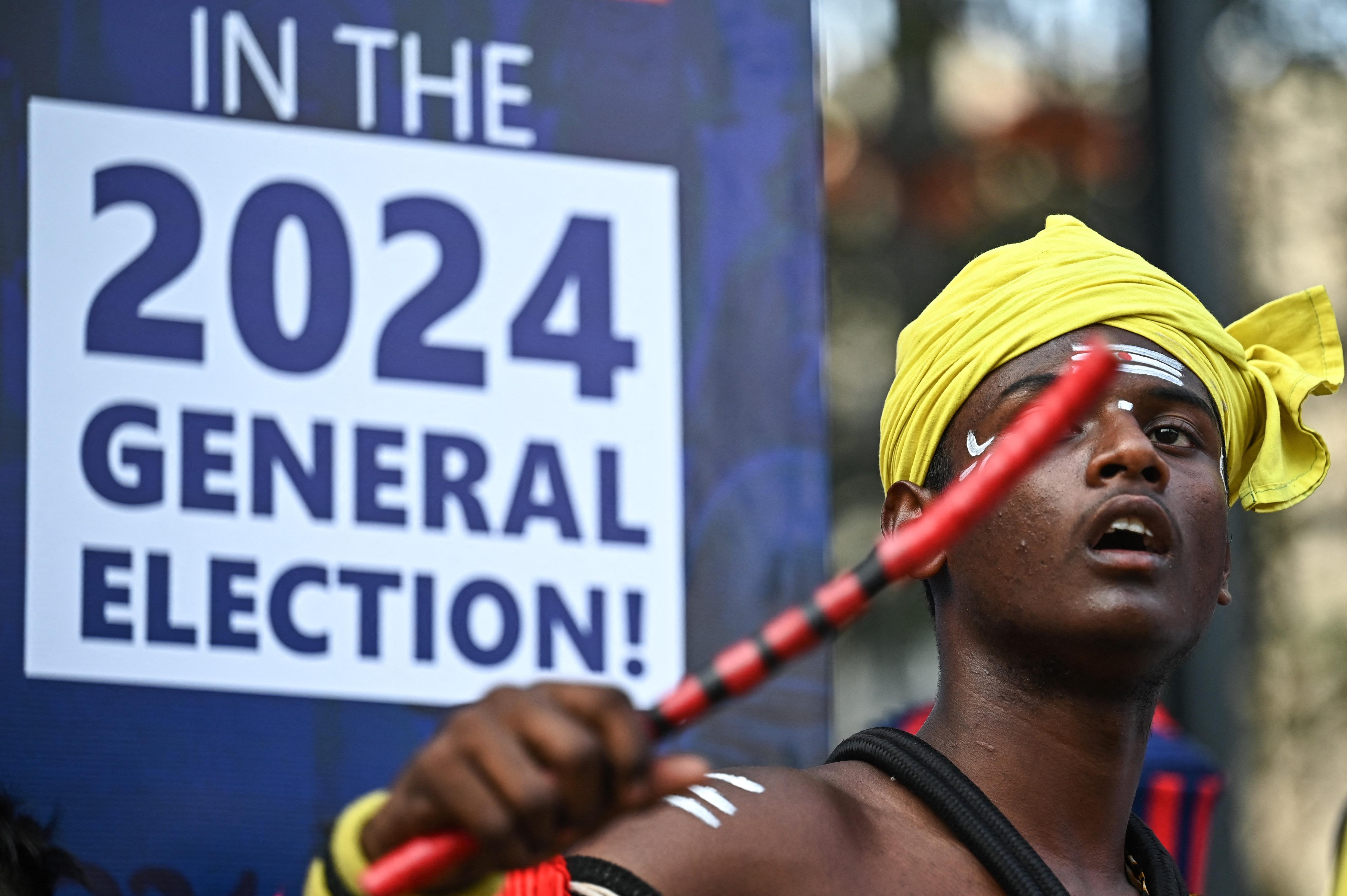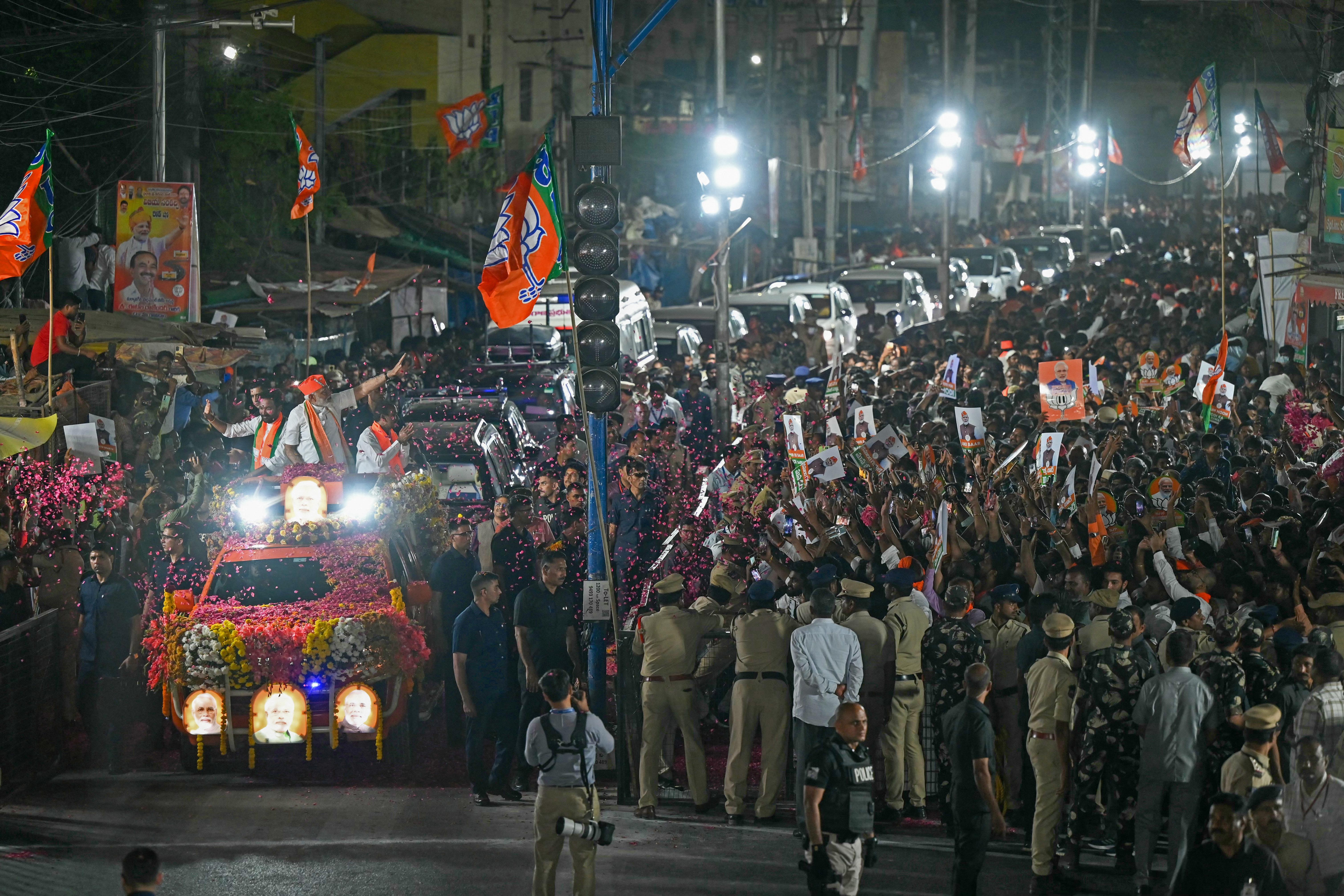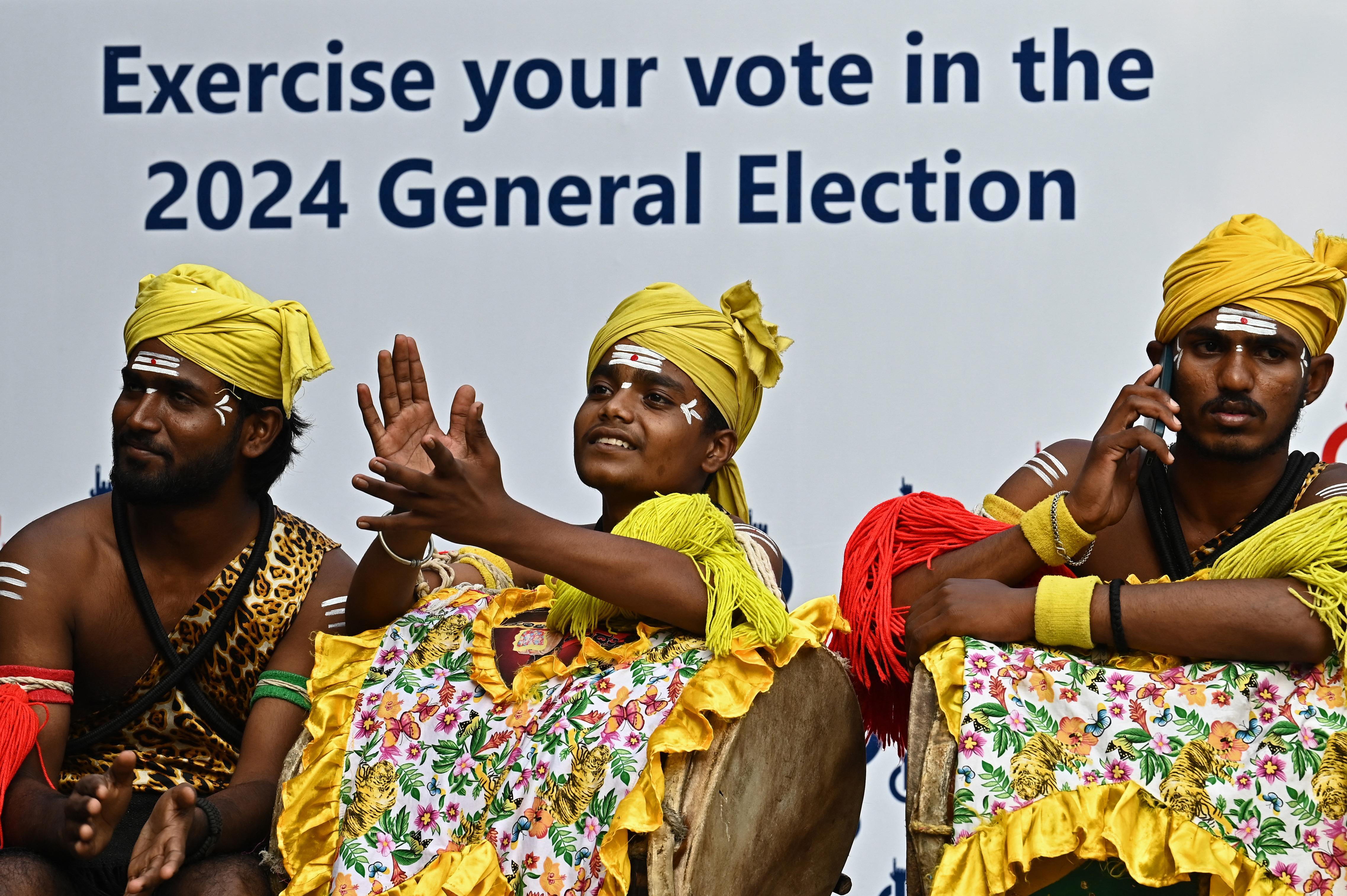
An artist dressed in a traditional attire performs in front of an election sign board during the Vote-A-Thon, an awareness campaign organized by the Karnataka's Chief Electoral Office to encourage 100 percent voting turnout for the upcoming 2024 general elections, in Bengaluru on March 17, 2024. India's election commission announced on March 16 that national polls would begin on April 19, with Hindu-nationalist Prime Minister Narendra Modi strongly favored to win a third term in the world's largest democracy. (PHOTO / AFP)
India’s multi-phase general elections this year are to range from April 19 to June 1, with most poll analysts predicting a victory for the party and coalition of Prime Minister Narendra Modi to secure him a third consecutive term in office.
The Election Commission of India – the country’s independent poll-conducting body – announced the dates for the 2024 general election on Saturday. The results will be announced on June 4, chief election commissioner Rajiv Kumar told a news conference in New Delhi Saturday.
Over 970 million voters will elect 543 members for the lower house of Indian Parliament for a five-year term. “Indians will together express their will once again,” Kumar said. The country schedules seven rounds of voting, with different states voting at various times.
Voters will cast their votes through 5.5 million electronic voting machines. There will be more than a million polling stations. The Election Commission will deploy about 15 million polling staff and security personnel to conduct the elections, according to the Election Commission
A model code of conduct also came into effect; campaign rules now apply, and no political party or leader in the country, including Modi’s government, is allowed to announce new policies or welfare schemes that could influence voters.
ALSO READ: Election commission: Nearly 970m eligible voters in India
After April 19, the other voting dates are April 26, May 7, May 13, May 20, May 25 and June 1. Some states will complete voting on a single day, while others will have voting spread over several phases.
Voters will cast their votes through 5.5 million electronic voting machines. There will be more than a million polling stations. The Election Commission will deploy about 15 million polling staff and security personnel to conduct the elections, according to the Election Commission.
“It should have been shortened and it is longer in comparison to 2019. Conducting elections during the hottest months of the year may affect the voters’ turnout,” said Prof Balveer Arora, chairman, Centre for Multilevel Federalism, New Delhi and former Professor of Political Science at Centre for Political Studies, Jawaharlal Nehru University, New Delhi. May and June are India’s hottest months.
Another reason for the multiphase election is the deployment of huge federal security forces, which is necessary to ensure a free and fair poll, experts said.
Welcoming the announcement of the election, Modi posted on X stating, “We are fully prepared for elections.
“I have full confidence that we will get the full affection and blessings” of voters for the third consecutive time, Modi said in a series of posts on X.
India has a parliamentary system of governance. The party holding the majority of the 543 members in the Parliament forms the government and selects one of its nominees to be prime minister.
Modi’s Bharatiya Janata Party, currently governing the country, also has a ruling alliance, National Democratic Alliance or NDA. The Indian National Congress or INC, the main opposition party, managed to win just 52 seats, and other regional parties won 98 seats.
Turnout in Indian elections is generally high, with voter turnout of over 67 percent, the highest ever recorded in the 2019 general election. The ruling BJP secured over 37 percent votes and won over 303 seats in 2019, and along with its coalition partners enjoyed a majority of 352 seats with a vote share of 45 percent.

India’s Prime Minister Narendra Modi (left) waves to his supporters from atop a vehicle during a road show as part of Bharatiya Janata Party's (BJP) election campaign ahead of national elections in Hyderabad on March 15, 2024. (PHOTO / AFP)
Modi, seeking a third straight term this time, has set a target of 370 seats for his party and 400-plus for the ruling alliance, NDA.
The 73-year-old Modi has been campaigning aggressively throughout the country and addressing numerous public and private meetings and taking part in religious events for months as he seeks a repeat of his landslide victory of 2014 and 2019. He was inaugurating plenty of new projects almost daily before the election date was announced.
To appeal to a wide range of voters, Modi has been highlighting India's economic progress in his speeches, stating that the country currently has the fastest-growing major economy in the world in addition to investments made in infrastructure and welfare schemes for the poor.
In January, Modi presided over the inauguration of a grand temple in Ayodhya, in north India which political analysts predicted that BJP will try to consolidate Hindu vote banks in a country where 80 per cent of the population is Hindu.
READ MORE: How Modi's BJP seeks Muslim vote in India's 2024 election
Inauguration of the Ram temple was an unofficial beginning of Modi’s election campaign because it fulfilled his party’s long standing demand, experts said then, though some questioned his role for a religious ceremony.
A survey conducted by the Pew Research Centre last year revealed that nearly eight in ten Indians have a favorable view of the current prime minister.
“Wherever I go, I can clearly see that Modi will become PM for the third time,” Amit Shah, India’s home minister and Modi’s most trusted leader, said in a speech this week.
A coalition of 20 opposition parties, led by the INC, will fight Modi. This alliance is known as INDIA, or the Indian National Developmental Inclusive coalition.

Artists dressed in traditional attires sit in front of a voting sign board during the Vote-A-Thon, an awareness campaign organized by the Karnataka's Chief Electoral Office to encourage 100 percent voting turnout for the upcoming 2024 general elections, in Bengaluru on March 17, 2024. (PHOTO / AFP)
Yet Modi and his BJP remains the most popular party, Amit Rajendra Dholakia, a professor of the dept of Political Science at The Maharaja Sayajirao University of Baroda, said.
There is no major negative factor which could create disenchantment among the people. Of course unemployment is a major problem but it will not impact support for BJP. National security, along with other issues will go in favor of BJP, Dholakia pointed out.
Another important factor is BJP’s organizational prowess, the party is already in poll mode for the last six months whereas the Opposition parties are still not united. There is a leadership crisis in INC at the top. All these factors will give advantage to BJP, added Dholakia.
READ MORE: World's biggest party: India's BJP plots epic scale election drive
India has about 2,660 registered political parties. In 2019, seven national parties, 43 regional parties and 623 unrecognised political parties contested in the elections.
A record 612 million people of a 912 million strong electorate cast their votes in the last general election, registering the highest ever voter turnout at 67.4 percent. Women’s participation also increased to an historic 67.18 percent in 2019. In all, about 8,054 candidates, including 3,461 independents, contested those elections.
The writer is a freelance journalist for China Daily.


